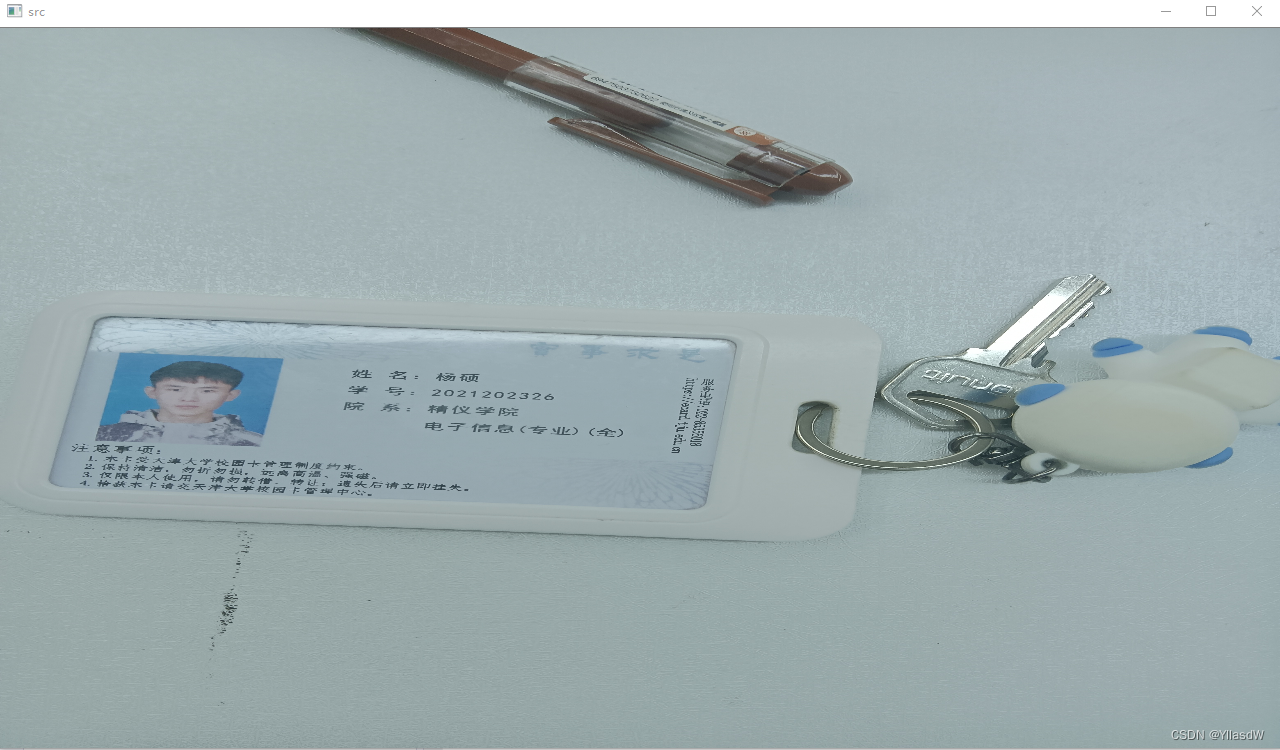针对这个问题,我找遍了全网,都没有找到这个代码,都是在水平方向进行相应的拼接过程,自己也是看了一些代码,试图去修改一下,然后展示出来,但是修改的过程总是出现问题.
重点来了,其实这个问题特别的容易解决,现在既然只能够实现水平拼接,那么将采集到的图片进行一个旋转,之后进行水平拼接,再将其旋转回去不就可以了吗.------是不是有种一语道破梦中人的感觉!(浪费了那么长时间去改代码,不如换一种思路去解决问题)
首先是实现相应的图片旋转的过程,代码是如下所示:
#include <windows.h>
#include <opencv2\opencv.hpp>
#include <iostream>
using namespace std;
using namespace cv;
int main()
{
Mat src = imread("C://Users//td//Desktop//相机图像大//7.jpg");
Mat dst;
Point center(src.cols / 2, src.rows / 2); //旋转中心
double angle = -90.0; //角度
double scale = 1.0; //缩放系数
Mat rotMat = getRotationMatrix2D(center, angle, scale);
warpAffine(src, dst, rotMat, src.size());
imshow("src", src);
Mat img_matchesOutput;
resize(dst, img_matchesOutput, Size(1280, 720));
imshow("MatchSIFT", img_matchesOutput);
waitKey();
}
结果示意图:

上面进行一个图片旋转的过程会产生相应的黑色区域,使得进行匹配的过程会出现问题,所以上面的过程是存在一定的问题的。
#include <opencv2/opencv.hpp>
using namespace cv;
int main()
{
Mat src = imread("C:\\Users\\td\\Desktop\\相机图像大/t1.jpg", 1);
Mat srcCopy = Mat(src.rows, src.cols, src.depth());
transpose(src, srcCopy);
//flip(srcCopy, srcCopy, 1); //rotate 270
flip(srcCopy, srcCopy, 0); //rotate 90
namedWindow("source Image", WINDOW_AUTOSIZE);
imshow("source Image", src);
namedWindow("Display Image", WINDOW_AUTOSIZE);
imshow("Display Image", srcCopy);
waitKey(0);
return 0;
}
这个过程是不存在黑色区域的,结果图如下:这里应当注意的是,这里的旋转方向是沿着逆时针进行旋转的,想要改变旋转方向需要改变相应的一个旋转参数。
旋转之前

旋转之后

后面是进行图片拼接的过程:图片拼接有好多方法,直接在网上进行一个调用就可以了。
方法一:opencv库里面自带的一个Stitcher,(要配置OpenCV环境)调用的代码如下所示:
#include <iostream>
#include <string>
#include <vector>
#include <opencv2/opencv.hpp>
#include <opencv2/core/core.hpp>
#include <opencv2/highgui.hpp>
#include <opencv2/stitching.hpp>
#include <opencv2/features2d/features2d.hpp>
#include <opencv2/xfeatures2d/nonfree.hpp>
int main()
{
//step 1. load img
std::vector<Mat> imgs;
Mat img1 = imread("D:/image/img1.png", IMREAD_COLOR);
Mat img2 = imread("D:/image/img2.png", IMREAD_COLOR);
imgs.emplace_back(img1);
imgs.emplace_back(img2);
//进行拼接的函数 Stitcher
Mat result;
Stitcher stitcher = Stitcher::createDefault(false);
Stitcher::Status status = stitcher.stitch(imgs, result);
if (status != Stitcher::OK)
{
std::string error_msg = "Can't stitch images, error code = " +
std::to_string(status);
printff(error_msg);
}
else
{
imshow("result", result);//这里的图片如果要是过大是显示不全的,可以调用一个改变图片大小的函数
}
waitKey(0);
return 0;
}方法二:SIFT +?RANSAC(这里需要说明一下配置环境,因为SIFT角点检测方法在OpenCV 3.x版本就申请了专利,因此,建议使用Opencv 2.9.0版本)
#include <opencv2/nonfree/features2d.hpp>
#include <opencv2/imgproc/imgproc.hpp>
#include <opencv2/nonfree/nonfree.hpp>
#include <opencv2/opencv.hpp>
#include <cv.h>
#include <highgui.h>
#include <iostream>
#include <stdio.h>
using namespace cv;
using namespace std;
int main()
{
initModule_nonfree();//初始化模块,使用SIFT或SURF时用到
Ptr<FeatureDetector> detector = FeatureDetector::create( "SURF" );//创建SIFT特征检测器,可改成SURF/ORB
Ptr<DescriptorExtractor> descriptor_extractor = DescriptorExtractor::create( "SURF" );//创建特征向量生成器,可改成SURF/ORB
Ptr<DescriptorMatcher> descriptor_matcher = DescriptorMatcher::create( "BruteForce" );//创建特征匹配器
if( detector.empty() || descriptor_extractor.empty() )
cout<<"fail to create detector!";
Mat src1 = imread("C:\\Users\\td\\Desktop\\相机图像大\\直杆拼接\\Pic_1.bmp");
//Mat src1 = imread("C:\\Users\\td\\Desktop\\相机图像大/t1.jpg");
Mat img1 = Mat(src1.rows, src1.cols, src1.depth());
transpose(src1, img1);
flip(img1, img1, 3); //rotate 90
Mat src2 = imread("C:\\Users\\td\\Desktop\\相机图像大\\直杆拼接\\Pic_2.bmp");
//Mat src2 = imread("C:\\Users\\td\\Desktop\\相机图像大/t2.jpg");
Mat img2 = Mat(src2.rows, src2.cols, src2.depth());
transpose(src2, img2);
flip(img2, img2, 3); //rotate 90
//特征点检测
double t = getTickCount();//当前滴答数
vector<KeyPoint> m_LeftKey,m_RightKey;
detector->detect( img1, m_LeftKey );//检测img1中的SIFT特征点,存储到m_LeftKey中
detector->detect( img2, m_RightKey );
cout<<"图像1特征点个数:"<<m_LeftKey.size()<<endl;
cout<<"图像2特征点个数:"<<m_RightKey.size()<<endl;
//根据特征点计算特征描述子矩阵,即特征向量矩阵
Mat descriptors1,descriptors2;
descriptor_extractor->compute( img1, m_LeftKey, descriptors1 );
descriptor_extractor->compute( img2, m_RightKey, descriptors2 );
t = ((double)getTickCount() - t)/getTickFrequency();
cout<<"SIFT算法用时:"<<t<<"秒"<<endl;
cout<<"图像1特征描述矩阵大小:"<<descriptors1.size()
<<",特征向量个数:"<<descriptors1.rows<<",维数:"<<descriptors1.cols<<endl;
cout<<"图像2特征描述矩阵大小:"<<descriptors2.size()
<<",特征向量个数:"<<descriptors2.rows<<",维数:"<<descriptors2.cols<<endl;
//画出特征点
Mat img_m_LeftKey,img_m_RightKey;
drawKeypoints(img1,m_LeftKey,img_m_LeftKey,Scalar::all(-1),0);
drawKeypoints(img2,m_RightKey,img_m_RightKey,Scalar::all(-1),0);
//imshow("Src1",img_m_LeftKey);
//imshow("Src2",img_m_RightKey);
//特征匹配
vector<DMatch> matches;//匹配结果
descriptor_matcher->match( descriptors1, descriptors2, matches );//匹配两个图像的特征矩阵
cout<<"Match个数:"<<matches.size()<<endl;
//计算匹配结果中距离的最大和最小值
//距离是指两个特征向量间的欧式距离,表明两个特征的差异,值越小表明两个特征点越接近
double max_dist = 0;
double min_dist = 100;
for(int i=0; i<matches.size(); i++)
{
double dist = matches[i].distance;
if(dist < min_dist) min_dist = dist;
if(dist > max_dist) max_dist = dist;
}
cout<<"最大距离:"<<max_dist<<endl;
cout<<"最小距离:"<<min_dist<<endl;
//筛选出较好的匹配点
vector<DMatch> goodMatches;
for(int i=0; i<matches.size(); i++)
{
if(matches[i].distance < 0.2 * max_dist)
{
goodMatches.push_back(matches[i]);
}
}
cout<<"goodMatch个数:"<<goodMatches.size()<<endl;
//画出匹配结果
Mat img_matches;
//红色连接的是匹配的特征点对,绿色是未匹配的特征点
drawMatches(img1,m_LeftKey,img2,m_RightKey,goodMatches,img_matches,
Scalar::all(-1)/*CV_RGB(255,0,0)*/,CV_RGB(0,255,0),Mat(),2);
Mat img_matchesOutput2;
resize(img_matches, img_matchesOutput2, Size(1280, 720));
imshow("MatchSIFT", img_matchesOutput2);
IplImage result=img_matches;
waitKey(0);
//RANSAC匹配过程
vector<DMatch> m_Matches=goodMatches;
// 分配空间
int ptCount = (int)m_Matches.size();
Mat p1(ptCount, 2, CV_32F);
Mat p2(ptCount, 2, CV_32F);
// 把Keypoint转换为Mat
Point2f pt;
for (int i=0; i<ptCount; i++)
{
pt = m_LeftKey[m_Matches[i].queryIdx].pt;
p1.at<float>(i, 0) = pt.x;
p1.at<float>(i, 1) = pt.y;
pt = m_RightKey[m_Matches[i].trainIdx].pt;
p2.at<float>(i, 0) = pt.x;
p2.at<float>(i, 1) = pt.y;
}
// 用RANSAC方法计算F
Mat m_Fundamental;
vector<uchar> m_RANSACStatus; // 这个变量用于存储RANSAC后每个点的状态
findFundamentalMat(p1, p2, m_RANSACStatus, FM_RANSAC);
// 计算野点个数
int OutlinerCount = 0;
for (int i=0; i<ptCount; i++)
{
if (m_RANSACStatus[i] == 0) // 状态为0表示野点
{
OutlinerCount++;
}
}
int InlinerCount = ptCount - OutlinerCount; // 计算内点
cout<<"内点数为:"<<InlinerCount<<endl;
// 这三个变量用于保存内点和匹配关系
vector<Point2f> m_LeftInlier;
vector<Point2f> m_RightInlier;
vector<DMatch> m_InlierMatches;
m_InlierMatches.resize(InlinerCount);
m_LeftInlier.resize(InlinerCount);
m_RightInlier.resize(InlinerCount);
InlinerCount=0;
float inlier_minRx=img1.cols; //用于存储内点中右图最小横坐标,以便后续融合
for (int i=0; i<ptCount; i++)
{
if (m_RANSACStatus[i] != 0)
{
m_LeftInlier[InlinerCount].x = p1.at<float>(i, 0);
m_LeftInlier[InlinerCount].y = p1.at<float>(i, 1);
m_RightInlier[InlinerCount].x = p2.at<float>(i, 0);
m_RightInlier[InlinerCount].y = p2.at<float>(i, 1);
m_InlierMatches[InlinerCount].queryIdx = InlinerCount;
m_InlierMatches[InlinerCount].trainIdx = InlinerCount;
if(m_RightInlier[InlinerCount].x<inlier_minRx) inlier_minRx=m_RightInlier[InlinerCount].x; //存储内点中右图最小横坐标
InlinerCount++;
}
}
// 把内点转换为drawMatches可以使用的格式
vector<KeyPoint> key1(InlinerCount);
vector<KeyPoint> key2(InlinerCount);
KeyPoint::convert(m_LeftInlier, key1);
KeyPoint::convert(m_RightInlier, key2);
// 显示计算F过后的内点匹配
Mat OutImage;
drawMatches(img1, key1, img2, key2, m_InlierMatches, OutImage);
//cvNamedWindow( "Match features", 1);
//cvShowImage("Match features", &IplImage(OutImage));
waitKey(0);
cvDestroyAllWindows();
//矩阵H用以存储RANSAC得到的单应矩阵
Mat H = findHomography( m_LeftInlier, m_RightInlier, RANSAC );
//存储左图四角,及其变换到右图位置
std::vector<Point2f> obj_corners(4);
obj_corners[0] = Point(0,0); obj_corners[1] = Point( img1.cols, 0 );
obj_corners[2] = Point( img1.cols, img1.rows ); obj_corners[3] = Point( 0, img1.rows );
std::vector<Point2f> scene_corners(4);
perspectiveTransform( obj_corners, scene_corners, H);
//画出变换后图像位置
Point2f offset( (float)img1.cols, 0);
line( OutImage, scene_corners[0]+offset, scene_corners[1]+offset, Scalar( 0, 255, 0), 4 );
line( OutImage, scene_corners[1]+offset, scene_corners[2]+offset, Scalar( 0, 255, 0), 4 );
line( OutImage, scene_corners[2]+offset, scene_corners[3]+offset, Scalar( 0, 255, 0), 4 );
line( OutImage, scene_corners[3]+offset, scene_corners[0]+offset, Scalar( 0, 255, 0), 4 );
imshow( "Good Matches & Object detection", OutImage );
Mat img_matchesOutput3;
resize(OutImage, img_matchesOutput3, Size(1280, 720));
imshow("Good Matches & Object detection", img_matchesOutput3);
/* while(1)
{
if(waitKey(100)==19) cvSaveImage("E:\\warp_position.jpg", &IplImage(OutImage));
if(waitKey(100)==27) break;
} //按esc继续,ctl+s保存图像
*/
int drift = scene_corners[1].x; //储存偏移量
//新建一个矩阵存储配准后四角的位置
int width = int(max(abs(scene_corners[1].x), abs(scene_corners[2].x)));
int height= img1.rows; //或者:int height = int(max(abs(scene_corners[2].y), abs(scene_corners[3].y)));
float origin_x=0,origin_y=0;
if(scene_corners[0].x<0) {
if (scene_corners[3].x<0) origin_x+=min(scene_corners[0].x,scene_corners[3].x);
else origin_x+=scene_corners[0].x;}
width-=int(origin_x);
if(scene_corners[0].y<0) {
if (scene_corners[1].y) origin_y+=min(scene_corners[0].y,scene_corners[1].y);
else origin_y+=scene_corners[0].y;}
//可选:height-=int(origin_y);
Mat imageturn=Mat::zeros(width,height,img1.type());
//获取新的变换矩阵,使图像完整显示
for (int i=0;i<4;i++) {scene_corners[i].x -= origin_x; } //可选:scene_corners[i].y -= (float)origin_y; }
Mat H1=getPerspectiveTransform(obj_corners, scene_corners);
//进行图像变换,显示效果
warpPerspective(img1,imageturn,H1,Size(width,height));
Mat img_matchesOutput4;
resize(imageturn, img_matchesOutput4, Size(1280, 720));
imshow("image_Perspective", img_matchesOutput4);
waitKey(0);
//图像融合
int width_ol=width-int(inlier_minRx-origin_x);
int start_x=int(inlier_minRx-origin_x);
cout<<"width: "<<width<<endl;
cout<<"img1.width: "<<img1.cols<<endl;
cout<<"start_x: "<<start_x<<endl;
cout<<"width_ol: "<<width_ol<<endl;
uchar* ptr=imageturn.data;
double alpha=0, beta=1;
for (int row=0;row<height;row++) {
ptr=imageturn.data+row*imageturn.step+(start_x)*imageturn.elemSize();
for(int col=0;col<width_ol;col++)
{
uchar* ptr_c1=ptr+imageturn.elemSize1(); uchar* ptr_c2=ptr_c1+imageturn.elemSize1();
uchar* ptr2=img2.data+row*img2.step+(col+int(inlier_minRx))*img2.elemSize();
uchar* ptr2_c1=ptr2+img2.elemSize1(); uchar* ptr2_c2=ptr2_c1+img2.elemSize1();
alpha=double(col)/double(width_ol); beta=1-alpha;
if (*ptr==0&&*ptr_c1==0&&*ptr_c2==0) {
*ptr=(*ptr2);
*ptr_c1=(*ptr2_c1);
*ptr_c2=(*ptr2_c2);
}
*ptr=(*ptr)*beta+(*ptr2)*alpha;
*ptr_c1=(*ptr_c1)*beta+(*ptr2_c1)*alpha;
*ptr_c2=(*ptr_c2)*beta+(*ptr2_c2)*alpha;
ptr+=imageturn.elemSize();
} }
//imshow("image_overlap", imageturn);
//waitKey(0);
Mat img_result=Mat::zeros(height,width+img2.cols-drift,img1.type());
uchar* ptr_r=imageturn.data;
for (int row=0;row<height;row++) {
ptr_r=img_result.data+row*img_result.step;
for(int col=0;col<imageturn.cols;col++)
{
uchar* ptr_rc1=ptr_r+imageturn.elemSize1(); uchar* ptr_rc2=ptr_rc1+imageturn.elemSize1();
uchar* ptr=imageturn.data+row*imageturn.step+col*imageturn.elemSize();
uchar* ptr_c1=ptr+imageturn.elemSize1(); uchar* ptr_c2=ptr_c1+imageturn.elemSize1();
*ptr_r=*ptr;
*ptr_rc1=*ptr_c1;
*ptr_rc2=*ptr_c2;
ptr_r+=img_result.elemSize();
}
ptr_r=img_result.data+row*img_result.step+imageturn.cols*img_result.elemSize();
for(int col=imageturn.cols;col<img_result.cols;col++)
{
uchar* ptr_rc1=ptr_r+imageturn.elemSize1(); uchar* ptr_rc2=ptr_rc1+imageturn.elemSize1();
uchar* ptr2=img2.data+row*img2.step+(col-imageturn.cols+drift)*img2.elemSize();
uchar* ptr2_c1=ptr2+img2.elemSize1(); uchar* ptr2_c2=ptr2_c1+img2.elemSize1();
*ptr_r=*ptr2;
*ptr_rc1=*ptr2_c1;
*ptr_rc2=*ptr2_c2;
ptr_r+=img_result.elemSize();
}
}
Mat img_matchesOutput5;
resize(img_result, img_matchesOutput5, Size(1280, 720));
imshow("image_result", img_matchesOutput5);
/*
while(1)
{
if(waitKey(100)==19) cvSaveImage("E:\\final_result.jpg", &IplImage(img_result));
if(waitKey(100)==27) break; //按esc退出,ctl+s保存图像
}
*/
return 0;
}
当然是还有其他的方法,SIFT毕竟检测速度并不是很快,其余的方法自行研究。